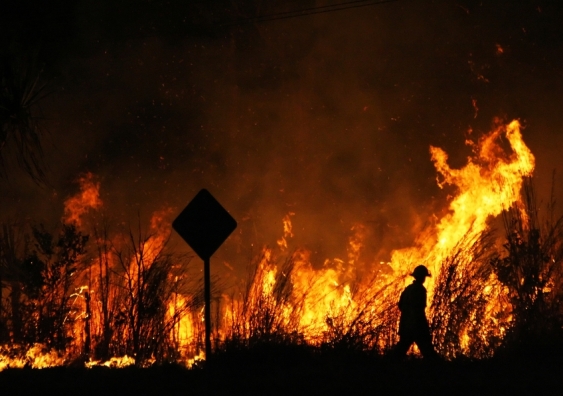Crucial Tips for Bushfire Administration to Make Sure Fire Protection

Recognizing Bushfire Danger Levels
Recognizing the varying levels of bushfire threat is vital for reliable preparation and preparation in mitigating possible threats to lives and residential properties. Bushfire risk degrees are normally categorized based on aspects such as weather, gas accessibility, topography, and historic fire behavior. By comprehending these danger individuals, communities and degrees can proactively execute techniques to lower susceptability and improve resilience in the face of potential bushfire occasions.
The first level of bushfire threat is low risk, where the likelihood of a bushfire happening and triggering considerable damage is very little. Risky levels symbolize a substantial threat, with conditions conducive to rapid fire spread and extreme fire habits.
Comprehending these bushfire danger levels allows stakeholders to tailor their preparedness and action activities as necessary, guaranteeing a aggressive and effective strategy to bushfire management.
Establishing a Defensible Space
Reliable bushfire management starts with developing a defensible area around residential properties to boost defense versus possible fire risks. A defensible room is a buffer area that produces a barrier in between a structure and the bordering flammable plant life. This room acts as a critical line of protection, giving firemens a safe location to run and assisting to reduce the danger of a fire spreading out to the residential or commercial property.
When creating a defensible space, it is crucial to think about the format of the home and the bordering landscape. Cleaning vegetation, particularly very combustible plants, within a specific radius of the home can help prevent the quick spread of fires. In addition, keeping a well-irrigated zone around the building can additionally boost its defensibility.
Normal upkeep of the defensible space is vital to ensure its efficiency. This includes trimming looming branches, clearing dead plant life, and maintaining the location devoid of debris. By investing effort and time into developing and preserving a defensible area, home proprietors can significantly enhance their possibilities of securing their homes and possessions throughout a bushfire.
Executing Fire-Resistant Landscape Design
When designing landscapes to mitigate the risk of bushfires, incorporating fireproof elements is necessary for improving property defense and lowering fire risks. Select plants with high moisture web content, low oil web content, and minimal dead plants to lower the risk of fire spread.

Creating an Emergency Discharge Plan
Establishing a detailed emergency emptying strategy is critical for making sure the safety and wellness of individuals throughout prospective bushfire events (BAL Report). An efficient evacuation plan need to outline clear treatments to follow in case of a bushfire danger, consisting of assigned evacuation courses, setting up points, and communication methods
To start creating an emergency situation discharge plan, it is vital to examine the certain risks and vulnerabilities of your location. Determine multiple evacuation paths that lead to secure areas away from the fire, thinking about elements such as surface, roadway ease of access, and potential threats. Develop communication channels to alert homeowners of an upcoming emptying, making use of methods such as alarms, text notifies, or door-to-door alerts.
Routinely review and exercise the emptying strategy with all homeowners or neighborhood members to ensure everybody recognizes their responsibilities and functions. Conduct drills to test the performance of the strategy and make any required adjustments. By having a well-prepared emptying plan in location, you can improve the chances of a secure and organized discharge during a bushfire emergency situation.
Maintaining Fire Safety Equipment
After developing a thorough emergency discharge prepare for bushfire cases, it is crucial to prioritize the normal maintenance of fire safety equipment look at this site to make sure optimal functionality and readiness. Regular maintenance of fire security tools such as fire extinguishers, smoke alarm, fire alarm systems, and lawn sprinkler is vital in guarding lives and home during a bushfire. Performing regular evaluations, testing, and servicing of these devices by qualified specialists is important to guarantee they remain in functioning order when required.
Fire extinguishers ought to be examined consistently for stress degrees, noticeable damages, and appropriate performance. Smoke detectors need to have their batteries changed at the very least yearly and undergo monthly screening to guarantee they are operational. Emergency alarm and lawn sprinkler should be examined periodically to verify they are linked and functioning correctly. Additionally, it is necessary to keep fire security devices accessible, unblocked, and clearly identified for easy recognition throughout an emergency. By diligently keeping fire safety and security equipment, individuals can boost their readiness and feedback capacities in the event of a bushfire.
Conclusion
Finally, effective bushfire management involves understanding threat degrees, creating defensible rooms, applying fireproof landscape design, establishing emptying plans, and maintaining fire security equipment. By complying with these important ideas, people can guarantee better fire defense and safety and security for their homes and neighborhoods. It is very important to focus on aggressive measures to mitigate the dangers associated with bushfires and to be prepared for emergencies.
By understanding the subtleties of bushfire danger levels, creating defensible areas, carrying out fireproof landscaping, producing extensive discharge plans, and making sure the maintenance of fire safety equipment, individuals and communities can dramatically bolster their resilience versus the devastations of wildfires - Bushfire Risk. These pointers are not only essential for safeguarding against immediate fire threats but additionally for cultivating long-term fire defense techniques that can make a considerable difference in the face of intensifying bushfire dangers
High-risk levels symbolize a considerable hazard, with problems favorable to rapid fire spread and severe fire behavior. Regular maintenance of fire safety and security official website devices such as fire extinguishers, smoke detectors, fire alarm systems, and sprinkler systems is crucial in securing lives and property throughout a bushfire.In verdict, effective bushfire administration entails understanding threat levels, creating defensible rooms, executing fire-resistant landscaping, developing emptying plans, and preserving fire security devices.